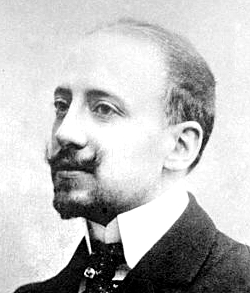Gabriele D'Annunzio
General Gabriele D'Annunzio, Prince of Montenevoso Italian; 12 March 1863 – 1 March 1938), sometimes written d'Annunzio, was an Italian ultra-nationalist, poet, playwright, orator, journalist, aristocrat, and army officer during World War I. He occupied a prominent place in Italian literature from 1889 to 1910 and later political life from 1914 to 1924. He was often referred to under the epithets Il Vate ("the Poet") or Il Profeta ("the Prophet").
D'Annunzio was associated with the Decadent movement in his literary works, which interplayed closely with French Symbolism and British Aestheticism. Such works represented a turn against the naturalism of the preceding romantics and was both sensuous and mystical. He came under the influence of Friedrich Nietzsche which would find outlets in his literary and later political contributions. His affairs with several women, including Eleonora Duse and Luisa Casati, received public attention.
During the First World War, perception of D'Annunzio in Italy transformed from literary figure into a national war hero. He was associated with the elite Arditi storm troops of the Italian Army and took part in actions such as the Flight over Vienna. As part of an Italian nationalist reaction against the Paris Peace Conference, he set up the short-lived Italian Regency of Carnaro in Fiume with himself as Duce. The constitution made "music" the fundamental principle of the state, which was corporatist in nature. Though D'Annunzio preached Italian ultranationalism and never called himself a fascist, he has been accused of partially inventing Italian fascism as both his ideas and aesthetics were an influence upon Benito Mussolini.
Literary work
He published Canto novo (1882), Terra vergine (1882), L'intermezzo di rime (1883), Il libro delle vergini (1884) and the greater part of the short stories that were afterwards collected under the general title of San Pantaleone (1886). Canto novo contains poems full of pulsating youth and the promise of power, some descriptive of the sea and some of the Abruzzese landscape, commented on and completed in prose by Terra vergine, the latter a collection of short stories dealing in radiant language with the peasant life of the author's native province. Intermezzo di rime is the beginning of D'Annunzio's second and characteristic manner. His conception of style was new, and he chose to express all the most subtle vibrations of voluptuous life. Both style and contents began to startle his critics; some who had greeted him as an enfant prodige rejected him as a perverter of public morals, whilst others hailed him as one bringing a breath of fresh air and an impulse of new vitality into the somewhat prim, lifeless work hitherto produced. Meanwhile, the review of D'Annunzio publisher Angelo Sommaruga perished in the midst of scandal, and his group of young authors found itself dispersed. Some entered the teaching career and were lost to literature, others threw themselves into journalism. Gabriele D'Annunzio took this latter course, and joined the staff of the Tribuna, under the pseudonym of "Duca Minimo". Here he wrote Il libro d'Isotta (1886), a love poem, in which for the first time he drew inspiration adapted to modern sentiments and passions from the rich colours of the Renaissance. Il libro d'Isotta is interesting also, because in it one can find most of the germs of his future work, just as in Intermezzo melico and in certain ballads and sonnets one can find descriptions and emotions which later went to form the aesthetic contents of Il piacere, Il trionfo della morte and Elegie romane (1892). D'Annunzio's first novel Il Piacere (1889, translated into English as The Child of Pleasure) was followed in 1891 by Giovanni Episcopo, and in 1892 by L'innocente (The Intruder). These three novels made a profound impression. L'innocente, admirably translated into French by Georges Herelle, brought its author the notice and applause of foreign critics. His next work, Il trionfo della morte (The Triumph of Death) (1894), was followed soon by Le vergini delle rocce (The Maidens of the Rocks) (1896) and Il fuoco (The Flame of Life) (1900 the latter is in its descriptions of Venice perhaps the most ardent glorification of a city existing in any language. A later phase of D'Annunzio's work is his dramatic production, represented by Il sogno di un mattino di primavera (1897), a lyrical fantasia in one act, and his Città Morta (The Dead City) (1898), written for Sarah Bernhardt
Children



Comments